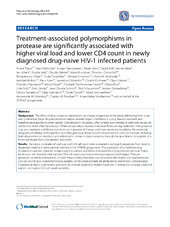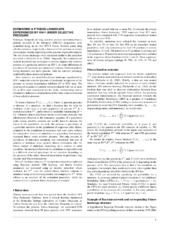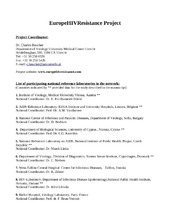| dc.contributor.author | Theys, Kristof | en_US |
| dc.contributor.author | Deforche, Koen | en_US |
| dc.contributor.author | Vercauteren, Jurgen | en_US |
| dc.contributor.author | Libin, Pieter | en_US |
| dc.contributor.author | van de Vijver, David A. M. C. | en_US |
| dc.contributor.author | Albert, Jan | en_US |
| dc.contributor.author | Åsjø, Birgitta | en_US |
| dc.contributor.author | Balotta, Claudia | en_US |
| dc.contributor.author | Bruckova, Marie | en_US |
| dc.contributor.author | Camacho, Ricardo J. | en_US |
| dc.contributor.author | Clotet, Bonaventura | en_US |
| dc.contributor.author | Coughlan, Suzie | en_US |
| dc.contributor.author | Grossman, Zehava | en_US |
| dc.contributor.author | Hamouda, Osamah | en_US |
| dc.contributor.author | Horban, Andrzei | en_US |
| dc.contributor.author | Korn, Klaus | en_US |
| dc.contributor.author | Kostrikis, Leondios G. | en_US |
| dc.contributor.author | Kücherer, Claudia | en_US |
| dc.contributor.author | Nielsen, Claus | en_US |
| dc.contributor.author | Paraskevis, Dimitrios | en_US |
| dc.contributor.author | Poljak, Mario | en_US |
| dc.contributor.author | Puchhammer-Stockl, Elisabeth | en_US |
| dc.contributor.author | Riva, Chiara | en_US |
| dc.contributor.author | Ruiz, Lidia | en_US |
| dc.contributor.author | Liitsola, Kirsi | en_US |
| dc.contributor.author | Schmit, Jean-Claude | en_US |
| dc.contributor.author | Schuurman, Rob | en_US |
| dc.contributor.author | Sönnerborg, Anders | en_US |
| dc.contributor.author | Stanekova, Danica | en_US |
| dc.contributor.author | Stanojevic, Maja | en_US |
| dc.contributor.author | Struck, Daniel | en_US |
| dc.contributor.author | Van Laethem, Kristel | en_US |
| dc.contributor.author | Wensing, Annemarie M. J. | en_US |
| dc.contributor.author | Boucher, Charles A. B. | en_US |
| dc.contributor.author | Vandamme, Anne-Mieke | en_US |
| dc.contributor.author | on behalf of the SPREAD-programme | en_US |
| dc.date.accessioned | 2014-11-18T09:36:46Z | |
| dc.date.available | 2014-11-18T09:36:46Z | |
| dc.date.issued | 2012-10-03 | eng |
| dc.identifier.issn | 1742-4690 | |
| dc.identifier.uri | https://hdl.handle.net/1956/8757 | |
| dc.description.abstract | Background: The effect of drug resistance transmission on disease progression in the newly infected patient is not well understood. Major drug resistance mutations severely impair viral fitness in a drug free environment, and therefore are expected to revert quickly. Compensatory mutations, often already polymorphic in wild-type viruses, do not tend to revert after transmission. While compensatory mutations increase fitness during treatment, their presence may also modulate viral fitness and virulence in absence of therapy and major resistance mutations. We previously designed a modeling technique that quantifies genotypic footprints of in vivo treatment selective pressure, including both drug resistance mutations and polymorphic compensatory mutations, through the quantitative description of a fitness landscape from virus genetic sequences. Results: Genotypic correlates of viral load and CD4 cell count were evaluated in subtype B sequences from recently diagnosed treatment-naive patients enrolled in the SPREAD programme. The association of surveillance drug resistance mutations, reported compensatory mutations and fitness estimated from drug selective pressure fitness landscapes with baseline viral load and CD4 cell count was evaluated using regression techniques. Protease genotypic variability estimated to increase fitness during treatment was associated with higher viral load and lower CD4 cell counts also in treatment-naive patients, which could primarily be attributed to well-known compensatory mutations at highly polymorphic positions. By contrast, treatment-relatedmutations in reverse transcriptase could not explain viral load or CD4 cell count variability. | en_US |
| dc.language.iso | eng | eng |
| dc.publisher | BioMed Central | eng |
| dc.rights | Attribution CC BY | eng |
| dc.rights.uri | http://creativecommons.org/licenses/by/2.0 | eng |
| dc.title | Treatment-associated polymorphisms in protease are significantly associated with higher viral load and lower CD4 count in newly diagnosed drug-naive HIV-1 infected patients | en_US |
| dc.type | Peer reviewed | |
| dc.type | Journal article | |
| dc.date.updated | 2013-08-23T09:05:09Z | |
| dc.description.version | publishedVersion | en_US |
| dc.rights.holder | Copyright 2012 Theys et al; licensee BioMed Central Ltd | |
| dc.rights.holder | Kristof Theys et al.; licensee BioMed Central Ltd. | |
| dc.source.articlenumber | 81 | |
| dc.identifier.doi | https://doi.org/10.1186/1742-4690-9-81 | |
| dc.identifier.cristin | 980525 | |
| dc.source.journal | Retrovirology | |
| dc.source.40 | 9 | |




